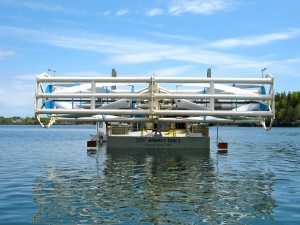On August 24th, NOAA's National Ocean Service and the Alaska Energy Authority (AEA) held a stakeholder meeting in Anchorage to discuss their partnership and project to assess the potential for tidal hydro kinetic energy in Cook Inlet. NOAA and AEA have signed an MOU in a funded partnership. Over the next few years, NOAA will be measuring and modeling water levels and three-dimensional current, salinity, and temperature within Cook Inlet to identify regions with strong currents to determine its potential and impact for the installation of hydrokinetic systems.
Around 50 people attended the meeting. There was a range of participants including state and federal agencies, NGOs, local interest groups, and members of the general public. Following the meeting, NOAA scientists conducted a 5-day reconnaissance mission in Cook Inlet to study aspects such as bottom type, depth, and salinity in different locations to help determine where to deploy sensors for baseline data.
Presentations
Overview of Cook Inlet Oceanography— Sue Saupe, CIRCAC
Design and Implementation of a NOAA/NOS Cook Inlet and Shelikof Straits Circulation Modeling System — Rich Patchen & Lyon Lanerolle, NOAA
Tidal Energy Technology and ORPC’s Projects in Cook Inlet — Monty Worthington, Ocean Renewable Power Company
Yukon River Hydrokinetic Project at Eagle — Ben Beste, Alaska Power & Telephone
Data and Information Needs for Hydrokinetic Energy Development — Jerome Johnson, Alaska Hydrokinetic Energy Research Center UAF
Assessing Potential Impacts of In-River Hydrokinetics on Juvenile Fishes — Parker Bradley, UAF School of Fisheries & Ocean Sciences

